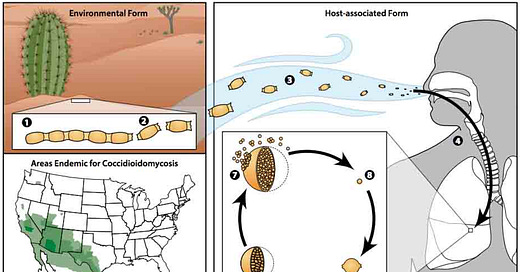Valley fever cases up 42% in Arizona as Valley Fever Awareness Week comes to a close
Valley Fever (medical name coccidioidomycosis [kok-sid-e-oy-do-my-co-sis] or "cocci" for short) is an infection of the lungs caused by a fungus (scientific name Coccidioides immitis or Coccidioides posadasii) that grows in the soil in Arizona, the southern and central portions of California and portions of Nevada, New Mexico, Texas, and Utah. The fungus was also recently found in south-central Washington. Valley Fever is also found in parts of Mexico, Central and South America. These areas where the fungus grows in the soil are called "endemic areas."
Today is the last day for The 22nd annual Valley Fever Awareness Week in Arizona, a week to spread public awareness of coccidioidomycosis, or Valley fever, across the state.
Health officials in Arizona are reporting an increase in Valley fever year to date in 2024. Through November 16, 12,522 cases have been reported. This is a 42 percent increase compared to the same period in 2023, when 8,841 cases were reported.
This is higher than any of the recent five years with a month and a half left in 2024.
There is also an increase reported nationally in the US—from 16,746 cases reported to date last year, to 22,244 cases reported today (a 33 percent increase).
According to the Arizona Department of Health Services, anyone who lives, visits, or travels through the areas where the fungus grows in the soil may acquire Valley fever. People working in certain occupations such as construction, excavation, agriculture, archaeological digging and other occupations which disturb soil in endemic areas may be at increased risk of exposure. Military personnel training in these areas are also at risk. Persons who pursue recreational activities such as biking or driving ATVs or 4-wheel drive vehicles in the desert may be at increased risk. Various domestic animals such as dogs and horses as well as wild animals are also susceptible.
Valley fever is acquired by breathing in airborne spores of the fungus Coccidioides. Valley fever is NOT spread from human to human, or animal to animal, or animal to human, or human to animal.
Coccidioidomycosis may be asymptomatic but typically presents as a self-limited respiratory illness or pneumonia. Patients may also present with erythema nodosum. However, infection can also lead to progressive pulmonary disease or severe disseminated disease including meningitis and can be fatal.






